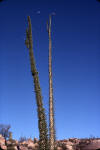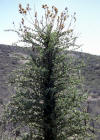|
 
Idria (Fouquieria)
columnaris
Vizcaíno Desert near Catavina, BCN
Feb 1979. Boojum Tree. This plant is
what makes plant life in Baja California
appear bizarre. It occurs mainly among rock outcrops similar to what
is seen in the Joshua Tree National
Park in California. It is found primarily in the central part of the
northern peninsula of Baja California south of San Pedro Martír,
and on Is. Guarda. In contrast to the ocotillo of southwestern US,
which produce red flowers (shown below), this one produces white to yellow
flowers at a time of the year when one does not want be traveling the
desert, July to August.
|
 
Idria (Fouquieria) columnaris
Vizcaíno Desert near Catavina, BCN
Feb 1979 |
|

Fouquieria diguetii.
Adam's Tree
(Palo Adán). Gulf Coast, near
Loreto, BCN.
Feb 1978 This species may be thought of as the ocotillo that occurs
in the subtropical desert thorn bush-land,
southern peninsula of Baja California (Mexico), in contrast to the
splendid ocotillo
found in the Chihuahuan and Sonoran Deserts. |

Fouquieria splendens.
Ocotillo.
Gulf Coast, near San Felipe, BCN
Mar 1994. |
|

Fouquieria splendens
Rio Grande, Big Bend Region, TX
Nov 1979 |

Fouquieria splendens
Encelia farinosa in flower in foreground
Kofa Mts., AZ
Apr 1973
|
  
Fouquieria splendens
Chuckwalla Mts., CA
Apr 1973
|
 
Fouquieria splendens
Anza Borego St. Park, CA
Photos by Sally Larsen
Mar 2005 |
|
Schultheis L.M. and
B. G. Baldwin. 1999. Molecular phylogenetics of Fouquieriaceae: evidence
from nuclear rDNA ITS studies. Am. J. Bot. 86(4): 578. “Molecular
sequence data from the 18S-26S rDNA internal transcribed spacer (ITS)
region support the monophyly of Fouquieria sensu lato (Fouquieriaceae) and
the three subgenera (subg. Fouquieria, subg. Bronnia, subg. Idria)
previously recognized within it. Resolution within subg. Fouquieria
differs somewhat between parsimony and maximum likelihood (ML) trees.
Section Fouquieria and sect. Ocotilla within subg. Fouquieria are not well
supported as monophyletic groups. Uncertainty regarding placement of the
root within Fouquieriaceae makes discussion of character evolution within
the family difficult. Three root positions are consistent with
rate-constant evolution of ITS sequences: (1) along the branch to subg.
Idria, (2) along the branch to subg. Bronnia, and (3) along the branch to
subg. Fouquieria. The first root position listed is equivalent to an
outgroup rooting. The third root position listed is equivalent to a
midpoint rooting. Of the three root positions above, only the third is
along a branch that may be sufficiently long to act as a long-branch
attractor. The first two root positions would result in character
reconstruction suggesting that succulent growth forms and white floral
pigmentation are ancestral within the family, with shifts to woody growth
forms and to red floral pigmentation. The third root position results in
equivocal reconstruction of the ancestral growth form, equivocal
reconstruction of ancestral floral pigmentation in parsimony trees, and a
suggestion of white floral pigmentation as ancestral in ML trees. Two
previous hypotheses of polyploid origins are compatible with the molecular
data presented here: (1) origin of the tetraploid F. diguetii from F.
macdougalii, and (2) allopolyploid origin of the hexaploid F. burragei
from the tetraploid F. diguetii and a diploid species similar to F.
splendens. Direct descent of the hexaploid F. columnaris from the subg.
Bronnia lineage is not supported by our data. An amphiploid origin of F.
columnaris involving a member of the subg. Bronnia lineage and an extinct
taxon outside subg. Bronnia, however, cannot be ruled out.”
|